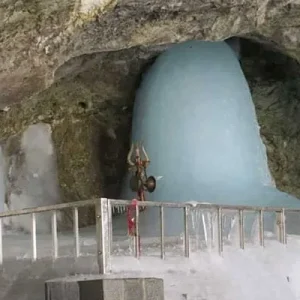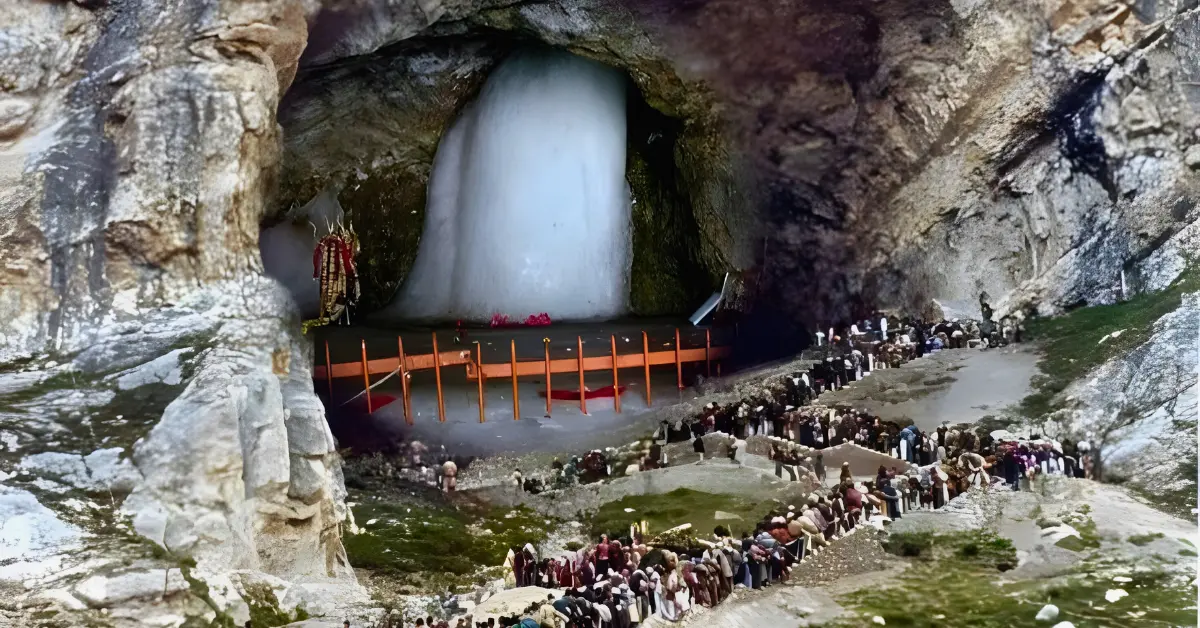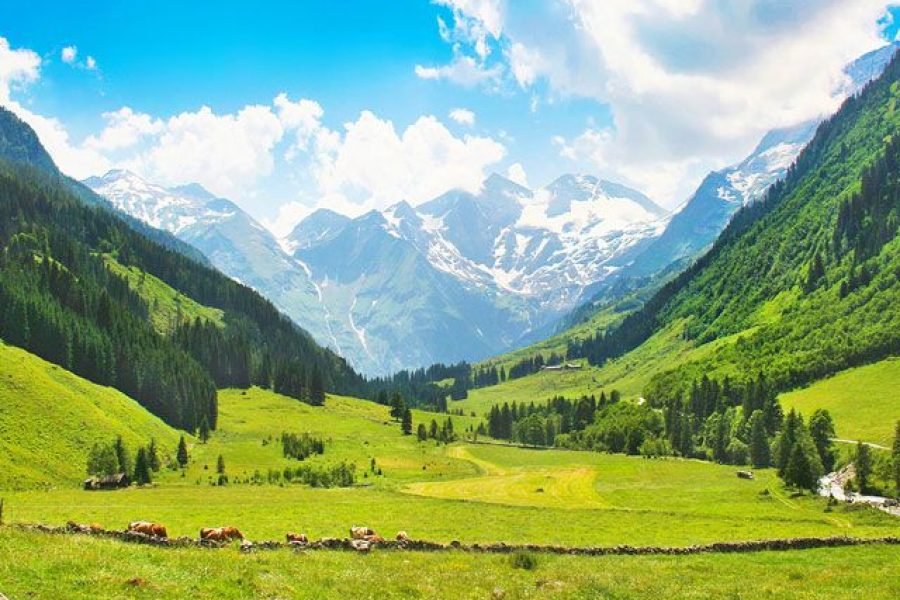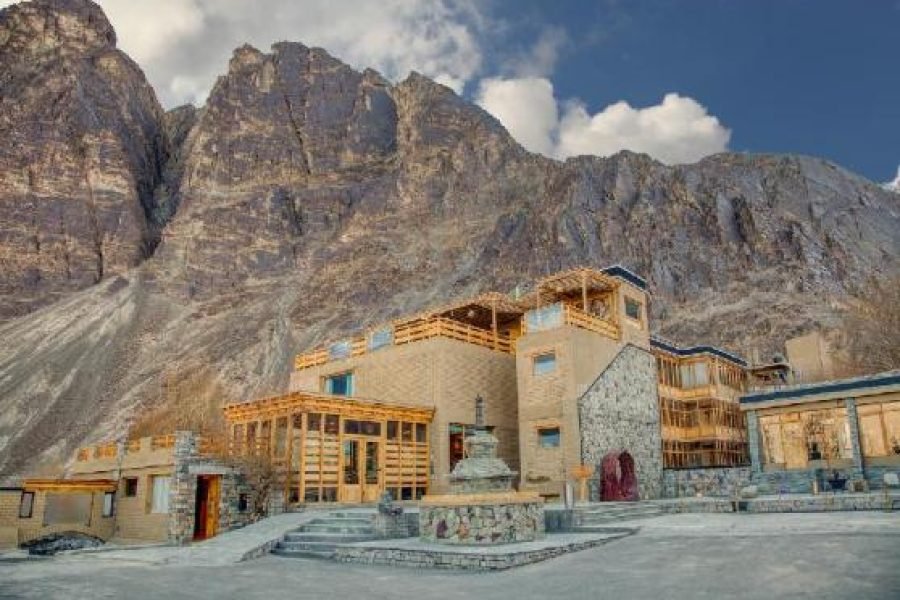Amarnath Cave Shrine : A Journey into Divinity





Table of Contents
Toggle1. Introduction
Located high up in the Himalayas, deep into the snow cover is the Amarnath Cave Shrine, one of the most sacred pilgrimage sites of India. Dedicated to Lord Shiva, this shrine receives much attention for its naturally occurring ice Shiva Lingam that takes shape every year during the summer season. Located in the Anantnag district of Jammu and Kashmir, it is said to attract hundreds of thousands of pilgrims a year who undertake this difficult pilgrimage along with the rugged terrain to witness this heavenly vision. Amarnath Yatra is an amalgamation of a pilgrimage as well as a tradition that holds great cultural significance in Hinduism.
The importance of the Amarnath Shrine goes beyond its religious ideology. It is the epitome of faith, resilience and devotion that draws people from all over India as well as foreign lands to be a part of this revered shrine. This guide provides the historical background and geographical description of the place, its religious importance, and the hurdles posed by the Amarnath Yatra, which forms an overall look at this sacred place.
2. Historical Background
Long back the roots of Amarnath Shrine date from ancient Hindu mythology. There are many legends connected with the origin of this shrine. The most common legend has to do with Lord Shiva and his consort Parvati. According to the story, Lord Shiva wanted to reveal the secret of immortality to Parvati, so he took her to a cave in the mountains of Kashmir. He revealed the secret while seated inside the cave, which is today referred to as the Amarnath Cave.
According to legend, he, after revealing the secret, left the place along with his divine symbols: his bull Nandi, moon, and serpent, and further instructed the formation of the sacred Shiva Lingam that continues to take place every year. An ice lingam has the intention to assume a form for the person, as it actually considers as Lord Shiva himself, and, hence, by visiting the pilgrimage site, it provides the experience of being purely divine for Hindus.
Several ancient texts have referred to the shrine, including the “Skanda Purana” and “Shiv Mahapuran.” The site had been a center for pilgrims for several centuries but came to be more properly developed as a place of pilgrimage in the 19th century when Maharaja Ranbir Singh of Jammu and Kashmir was ruling. The mass revival of the pilgrimage in the 20th century led to the annual pilgrimage that is conducted to this day and continues to gain in number each year.
3. Geography and Location
The Amarnath Cave Shrine stands at an elevation of approximately 3,888 meters or 12,756 feet above sea level. The cave stands approximately 19 meters long and 16 meters in width and is situated deep within the Himalayas. The shrine is situated in the Pahalgam region of Jammu and Kashmir and dominates with tall snow-capped peaks and deep valleys around the location.
The pilgrimage needs to cover a tiring journey on rough roads passing through narrow twisting ways and steep hills. The routes of trekking from Baltal or Pahalgam make the beginning of most the treks up to the shrine. Both the routes have their own alternatives as far as challenges and scenic beauty are concerned. These pilgrims cross the high-altitude passes over the rugged terrains and sometimes below-freezing temperatures.
A good geographical location further adds to the mystique and the aura of the Amarnath Cave. The natural beauty of the surrounding environments is bound to add to the spiritutal atmosphere for such an ethereal connection between nature and the divine.
4. Religious Importance
The Amarnath Shrine is such a place that words cannot do justice to it. Among the pilgrims, Amarnath Shrine is probably one of the places most sacred for the Hindus, its level of holiness being comparable only to Varanasi and Rishikesh. Some sort of journey of life has been equated with a trip to Amarnath Yatra – arduous, sacrificial, and absolutely persistent. It is said that doing the Yatra washes away all sins and brings one blessings from God Shiva himself.
The most striking feature of the shrine is the ice formation in the Shiva Lingam. It is formed in a natural process through every summer season, from July or August, and reaches its maximum size during this time. It is believed, mythologically, to depict the form of the highest manifestation of Lord Shiva’s energy. Thousands of devotees from all the corners of the country visit the shrine to seek divine blessings by offering prayers there.
The pilgrimage further involves religious rituals, prayers, and worship. Rituals are performed at certain points. At every such point, mantras have to be said, devotional hymns have to be chanted and milk, water, and flower offerings have to be made too .
5. The Amarnath Yatra
Amarnath Yatra is one of the longest and exhausting pilgrimages that attract hundreds of thousands of devotees each year. The yatra typically happens in the summer months when the ice lingam is full. The devotees walk for days, sometimes through the entire country, from all other parts of India to the shrine to pray there.
There are two major routes: Pahalgam route and Baltal route. Pahalgam route is the long one, about 45 kilometers, taken by pilgrims through beautiful valleys and forests. Baltal route, though is a shorter route, about 14 kilometers in length, is much steeper and more demanding for physically fit pilgrims to face high-altitude trekking and extreme weather conditions.
The Yatra has every year to become a huge logistical operation, and in this regard, it involves the active participation of the government authorities, security forces, medical teams, and volunteers, ensuring the safety and wellbeing of pilgrims. Considering the physical demands, the pilgrimage is viewed by many as a test of faith and endurance.
6. Problems and Control
Although the Amarnath Yatra is one of the most sacred journeys, it has its share of imperfections. The terrain is tough and so is the weather, and such a high altitude adds to its physical nature as an exhausting trek. Most pilgrims were hit with altitude sickness and were also extremely tired.
Governments and local administrations are integral in the management of pilgrims as they keep into place safety measures, along with the administration of medical aid and other emergency services. There are temporary camps and medic stations en route for the pilgrims to avail themselves of. The overall security of the pilgrims is also taken care of due to the sensitive geopolitical area in which this region falls.
Environmental considerations also assume significance as the increase in number of devotees has put a question mark on the ecological impact of this sensitive area’s environment. There are efforts to minimize waste generation and protect natural habitats, as pilgrimage should not work at the cost of its sustainability.
7. Amarnath Shrine as a Cultural and Spiritual Destination
The Amarnath Shrine is not only culturally relevant to this area of Jammu and Kashmir but also shares certain religious value and brings together people from different parts of India, thus bringing a sense of unity and brotherhood among the Hindus. It’s not just a test of the body but it’s also a test of self discovery and devotion.
In addition, the inflow of pilgrims to Kashmir during Yatra further flourishes the local economy, and various locals are facilitated with the hospitality industry, offering accommodation, food and transport to the pilgrims. Hence, the pilgrimage is considered an indispensable part of the life of people in Kashmir and is closely associated with the rich cultural and religious heritage of the region.
8. Conclusion
As one of the most revered in Hinduism, the Amarnath Cave Shrine today attracts thousands of devotees every year because of its historical, religious, and geographical characteristics that represent faith, perseverance, and spiritual development. In spite of the difficulties faced during the Yatra, the shrine continues to attract pilgrims, really the embodiment of devotion among Hindus all over India.
The added task of preserving the environment and ensuring that all pilgrims remain safe and healthy is thus on the pilgrimage as it grows in number. The story therefore tells of spiritual journey, testifying to the strength of faith in the face of adversity for man. Significance will indeed continue to be translated to generations, especially times of needs where the shrine becomes a source of hope and blessings and closer bond with the divine.
How to book a trip to Amarnath Cave Shrine, India with Charzan Holidays?
For a seamless and exceptional booking experience, contact Charzan Holidays at reservations@charzan.in or call us at +919622224473
People ask FAQ's
1. What is inside Amarnath Cave?
Inside the Amarnath Cave is an ice stalagmite, considered a natural manifestation of the Shiva Lingam, the symbol of Lord Shiva. Devotees throng to the cave at an altitude of 3,888 meters to worship the sacred ice lingam, the manifestation of divine presence in the form of Lord Shiva.
2. What is the mystery behind Amarnath?
According to the legend, Lord Shiva wanted to reveal the secret of immortality to Parvati, so he took her to a cave in the mountains of Kashmir. He revealed the secret while seated inside the cave, which is today referred to as the Amarnath Cave. According to legend, he, after revealing the secret, left the place along with his divine symbols: his bull Nandi, moon, and serpent, and further instructed the formation of the sacred Shiva Lingam that continues to take place every year.
3. What is the oxygen level in Amarnath Cave?
It has an altitude of 3,888 meters or 12,756 feet. Therefore, the oxygen level inside the Amarnath Cave is much less than what exists at sea level. In this higher altitude region, oxygen is reduced by around 40 to 50%. Thus, the trek becomes very difficult for some pilgrims to breathe through. All pilgrims are advised to acclimatize before they step into their treks to avoid any possible altitude sickness.
4. Is Amarnath yatra difficult?
Yes, the Amarnath Yatra is quite challenging, especially because of the rugged terrain and high-altitude lands. The cave trek is about 12-14 kilometers long, crossed through steep ascents with unpredictable weather. This must prepare pilgrims for sharp temperatures, thin air, and chances of altitude sickness. But despite all this, the pilgrimage is a deeply spiritual journey for the devotees.
Frequently Asked Questions
1. What is the Amarnath Cave Shrine? | |
| The Amarnath Cave Shrine is a sacred Hindu pilgrimage site located in Jammu and Kashmir, dedicated to Lord Shiva. It is famous for the naturally occurring ice Shiva Lingam. | |
2. Why is the Amarnath Cave Shrine significant? | |
| The shrine holds immense spiritual significance for Hindus, believed to be the place where Lord Shiva revealed the secret of immortality to Goddess Parvati. | |
3. How do I reach Amarnath Cave Shrine? | |
| The shrine is accessible via two main trekking routes: from Pahalgam (approximately 45 kilometers) and from Baltal (approximately 14 kilometers). Helicopter services are also available from both locations. | |
4. What is the best time to visit Amarnath Cave Shrine? | |
| The best time to visit is during the annual Amarnath Yatra, typically held from late June to early August, coinciding with the Hindu month of Shravan. | |
5. What are the main features of the shrine? | |
| The cave features a naturally formed ice Shiva Lingam that waxes and wanes with the moon cycle, along with beautiful stalagmites and the surrounding snow-capped mountains. | |
6. Is there an entry fee for the shrine? | |
| No, there is no entry fee to visit the Amarnath Cave Shrine. However, pilgrims may need to register for the Yatra and pay for transportation and accommodations. | |
7. Are there any dress codes for visiting the shrine? | |
| Visitors are advised to wear modest clothing suitable for trekking. Comfortable shoes and warm clothing are recommended, especially due to the cold weather. | |
8. Can I offer prayers or perform rituals at the shrine? | |
| Yes, devotees can offer prayers and perform rituals at the shrine, including offering flowers and prasad. | |
9. Are there facilities available for visitors? | |
| Basic facilities such as medical camps, food stalls, and rest areas are provided along the trekking routes and near the shrine during the Yatra. | |
10. Is the Amarnath Cave Shrine safe for tourists? | |
| Yes, the shrine is generally safe for tourists. Adequate security and medical assistance are in place during the pilgrimage season. | |
11. Can I take photographs inside the shrine? | |
| Photography is not permitted inside the cave to maintain the sanctity of the site. However, you can take photos of the surrounding areas. | |
12. What local cuisine can I try near Amarnath Cave Shrine? | |
| There are limited food options near the shrine, but you can find vegetarian food and snacks at various stalls along the trekking routes and in nearby towns. | |
13. Are there accommodations nearby? | |
| Yes, there are various accommodation options in Pahalgam and Baltal, ranging from tents and guesthouses to hotels catering to pilgrims. | |
14. What should I be aware of before visiting? | |
| Be prepared for a challenging trek, carry sufficient water, and check local weather conditions. It’s also advisable to register for the Yatra in advance. | |
15. What is the local currency used in the area? | |
| The local currency is the Indian Rupee (INR). ATMs may be limited, so it’s advisable to carry cash for small purchases and donations. |









0 Comment